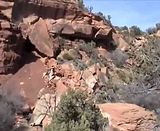For any person that has done a search on the internet looking for information about hunting with an Airedale Terrier they will more than likely come across a site called "Airedales Are A Failure". If one gets to reading the stuff published on the site it becomes pretty apparent that it's sole purpose is to trash the Airedale breed as hunters and a certain Airedale breeder.
From time to time the subject of this site has been brought to my attention and folks asked me what were my thoughts and position on it's content so here we go. I belong to several hunting dog message boards and saw first hand on what lead up to why the Airedale failure site was created, so in a nutshell!
Two members of a hunting dog forum who at one time were very friendly to each other got into an argument. What could of been squashed with proper moderation from the board owner was allowed to blossom into the most ugly internet war between two people I have ever witnessed. From dogs to world politics it festered and not only on the original board that it started on but to other message boards as well causing very ill feelings and some cases banning for both participants. I can not stress how out of hand this thing got and carried on for "Years!"
In the end bad enough for one combatant that was so incensed with anger to create a blog for the sole purpose of destroying the other's fellow's reputation and his livelihood as a hunting Airedale Terrier breeder and that also included doing his best to destroy the Airedale breed itself. I hate seeing things get to this extreme but it is what it is.
As for Airedales being a failure the fellow who owns the site has a right to his opinion, all I can say is to do your homework and research the breed. The Airedale is far from perfect but as can be seen from various published content on this blog and other sites there is plenty of evidence they can make for a pretty decent hunting dog on a wide variety of game and are not the failure one would have you believe.
Al Kranbuhl
HUNTING WITH AIREDALES
HUNTING WITH TRADITIONAL WORKING AIREDALE TERRIERS
Sunday, June 30, 2019
Wednesday, May 10, 2017
FIELD VS SHOW
Post by Airedale From NY on Feb 29, 2012 at 6:42pm
Long before and for as long I have been involved with Airedales there has always been controversy about the notion there are Airedales bred as field-hunting lines and there are Airedales that are bred for just showing or for the pet-companion trade and that they are different, this debate still continues today. The old well known Airedale hunting lines like Oorang, Ouachita, Cabin Hill and Mooreland to name a few will raise the hackles on any Airedale Terrier Club member when they are mentioned. This show dog vs field dog business is not just an Airedale Terrier controversy, the same type of debate goes on in other hunting breed circles also. Some of the other breeds I have owned and hunted with are caught up in pretty much the same crap.
All the hunting-sporting dog breeds have at least a few affectionados for the show ring, while some sporting breeds are favored for showing more than others all are shown by their breed club to some extent. One thing that is readily observed that more often than not there is a noticeable difference in appearance between field type hunting dogs that are seriously used by hunters and those that are primarily bred and raised to be shown or as pets. Lets take a look at those big differences in appearances that can and have occurred.
Irish-Red Setter field type hunting dog.

Irish Setter show dog.

From the show folks point of view they are all about breeding their dogs to fit the breed clubs standard to the point of obsession, they have a picture in their minds and a written decree of how their breed is supposed to look and to deviate from that look is sacrilege! Example, what is written in the paragraph below about Airedales pretty much sums up the show breeders mindset and criteria for their breed and is pretty much echoed for other dog breeds that hunt or work.
"There is no such thing as a working type of Airedale and a show type. The Airedale should be one dog not a field dog or a working dog, it is one dog. There is only one correct type of Airedale for any purpose he may be put to. There is no more excuse for breeding large, soft-coated, houndy eared, thick skulled, light eyed mutts, and calling them working-hunting type of Airedale"! Of course these rants are directed squarely at the old well known hunting lines mentioned above whom many times fit their berating description.
English Setter show type.
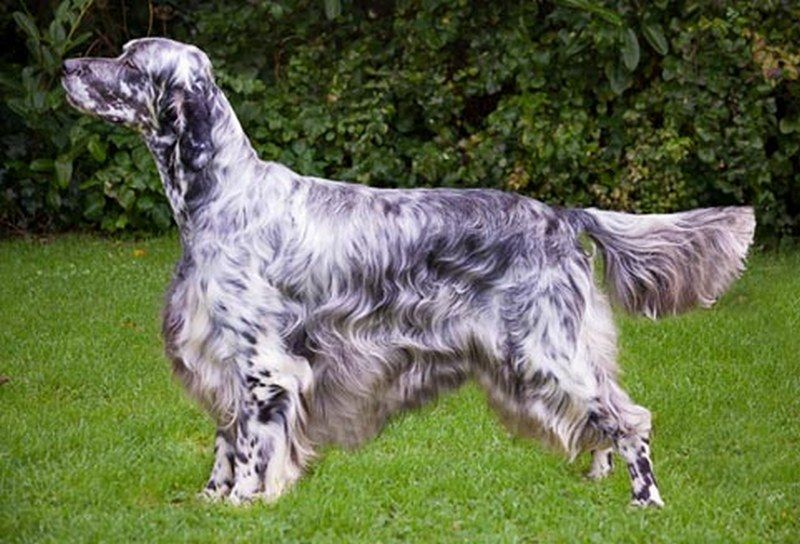
English Setter field type hunting dog.
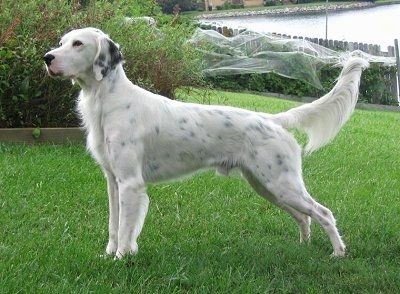
Serious hunters on the other hand have a different view and criteria, they are for the most part all about performance and by performance I mean after a hard day or night of tromping around in the field and woods looking to take some game they want their dogs to show something for their efforts and breed their dogs accordingly. Not only are hunting abilities taken into account but conformation which leads to speed and stamina along with the maintenance of a field dog's coat are important factors also.
The Setters pictured above are two glaring examples of the field vs show differences in the appearance department from what a hunter breeds and what the show crowd favors. From most accounts the Irish Setter after many many years and generations of total neglect in actual field performance testing has become almost useless as a hunting dog. The Red-Irish Setter field type has been brought back as a hunter in recent times and has become a decent performer as a hunter on birds again. The English Setter a breed of which I have had some limited experience has somewhat suffered the same fate to a lesser degree especially so when it comes to their coat, some of the show types still can hunt, find and point a bird but overall they are for the most part have seem to have fallen out of favor by hunters moving toward the field English Setter when it comes to hunting. There are other subtleties in appearance besides just the coat, the field dogs are somewhat smaller and lighter in build and speedier, the heads are different in shape and the ears of the field dogs are shorter.
What cracks me up is when I watch a big dog show on TV like Westminster and the announcer reads the breed club's hunting history behind these two popular hunting dog breeds and proceed to heap on accolades about their hunting prowess and how those long coats are there for protection from the briars and brambles. They believe and would like the public to believe that one could take those dogs out of the show ring and hit the field for a hunt and fill your vest's game bag with birds as long as the dog was trained properly. But the fact of the matter is most of those show breeders have never actually hunted their dogs or even tested them, and much the same happened with most of the relatives in these dog's pedigrees for generations. Yet they still assume it will be a great bird finder. Also I would like to hear an evaluation of how wonderful and practical those long protective coats are after a real day afield in the briars, brambles, stickers, dirt, water and ticks, then spending the rest of the day combing, grooming and cleaning that tangled messed up coat. Now I suppose if I owned a show coat Setter and it was a very good performer in the field I could shave the coat off but I believe a serious hunting dog should never have been bred for such a coat that drags on the ground in the first place, no real hunter would truly argue for it, it makes no practical sense!
Another breed that I have long time experience with is the Beagle, one of the oldest and refined hunting dog breeds in existence and even these little guys have subtle differences between the field-hunting version and the typical show Beagle. The beautiful hound pictured on top is a typical show type Beagle, black blanket back with tan head and white trim underneath and on the legs, in fact two Beagles closely resembling this dog won best in show at the big Westminster show in recent years.
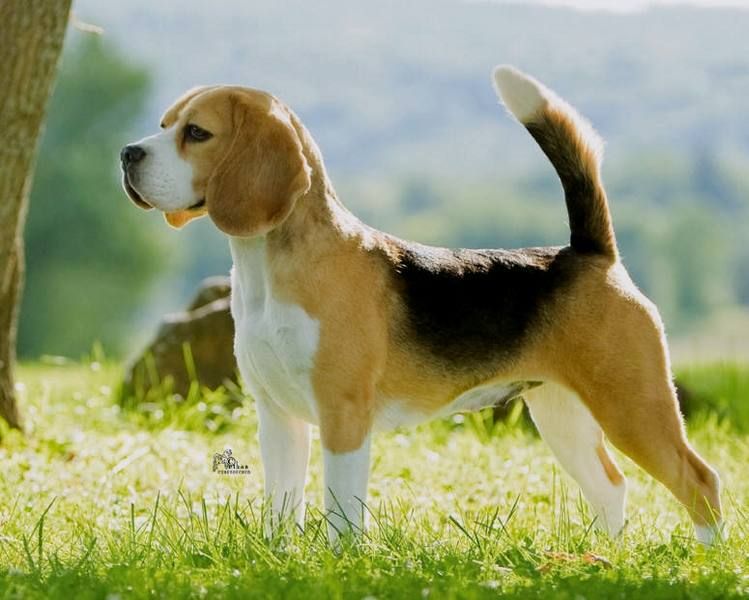
These two hounds are typical in look to the type of Beagle used by serious hunters and trial folks. A close look shows the differences between show and field especially in the head. Beagles can be of any typical hound color, bluetick, redtick, lemon and white, mostly white, and the black blanket back and tan which all the show types seem to be.
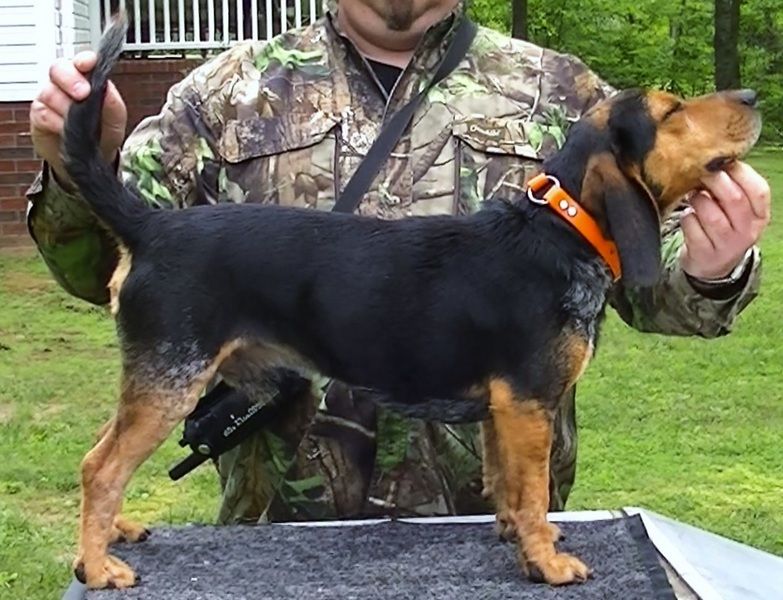
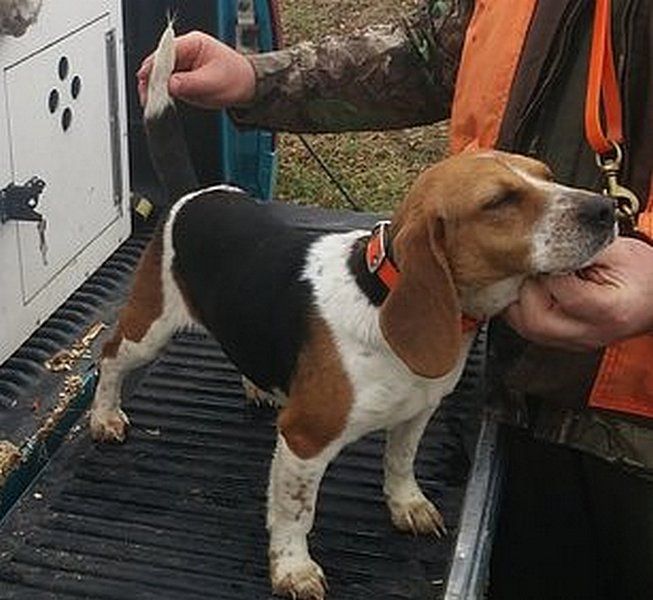
I can tell you as fact that sport Beaglers who hunt and trial are about as serious as they come and will spare no expense when it comes to their hounds. I can also say that all the hunting Beagles I have been around are much the same as the two pictured below the show type. The reason is a simple one, hunters want results, the field type Beagles are just better at real hunting and trials. Looking the part of a hunting dog is one thing but that is not enough of a qualification, for the serious hunters the dog has to act the part also.
While I am personally not a big fan of some German dog breeds I do like the way Germans go about breeding their hunting-working dogs. To be registered or certified in their breed club they must be tested and proven on game. Some of our Coon Hound registries do a similar test when single registration is opened. For instance a non registered grade Black and Tan must not only fall within the breed standard in look but that dog will have to prove it can tree a wild coon before it is accepted for registration. That in my opinion is a sound method in not only producing decent looking dogs but also dogs that live up to what the breed states they were bred to do in the first place.
I can go on and on citing examples like those above to the point of boredom but anyone that has taken the time to read the content of this blog will know what I am trying to convey to hunting dog breeders of all breeds but especially to the Airedalers who are attempting to breed the real deal, TEST, TEST, TEST! Believe me it does not take long hunting drives and abilities to fade without testing breeding stock and it bugs the Hell out of me to think of the Airedale Terrier going the way of the Irish Setter as a hunting dog.
I have been asked many times why do I not get involved with the Hunting Working Airedale group and put voice to all of this field vs show preaching and maybe some kind of opening of minds and meeting in the middle could be worked out. This very discussion was brought up and held a year or so ago by members of the Traditional Working Airedale board and below is what I had to say about it with no apologies.
=======================================
All I can say is that this HWA group has really lost it's way as to things pertaining to Traditional hunting with Airedale Terriers!
Back when this event was in it's formative stages I was contacted by one of the head honchos, I believe his name was Gilbert and he sent me a big packet of information explaining how the mission of the HWA group was to bring back the hunting Airedale.
I actually was excited and hoped between Henry Johnson's new Full Cry Airedale column and this HWA group that the hunting Airedale would get some exposure and a kickstart to be again considered a viable hunting dog for serious hunters. After reading the info in the packet I did have a couple of concerns. One was the involvement of the Airedale Club Of America and the other was this whole party was skewed to bird hunting.
My concern with the ATCA was they are blinded by the breed standard and they do not have a favorable view of the the Airedales that fail to fall within them. That included most of the so called hunting lines such as Mooreland and Ouachita, Redline types or mountain bred as they like to refer to them, the very Airedales lines I happened to favor simply because they were so much better at hunting. Also any Airedales from other registries like UKC would be out along with purebred grade dogs.
As for the bird hunting I knew that Airedales had a bit of a reputation for birds and over the years I in fact hunted both upland and waterfowl quite a bit with my own Airedales. That being said I never in my life have considered the Airedale breed "bird dogs". They are Terriers, varmints from Rats to Coons, big game from Lion to Bear is their claim to fame, fur hunting fools that just so happen to like hunting birds too.
Take a look at the three hunting categories on this message board, (and on this blog) it in itself is a pretty good representation of how Airedales are used for hunting and where most of the interest is, small and big game"FUR" hunting posts dominate bird hunting posts by an 8 to 1 margin.
Pickup any book that has information about Airedales hunting or go to any hunting dog message board and make a post about hunting with Airedales and I can assure you most of the information you will get will be about hunting some kind of "FUR"!
So I have a big problem when the said goal is to bring back the hunting Airedale but the event curriculum is so weak when it comes to testing for what game hunting Airedales are actually used for and famous for.
I was not then and I am still not against their bird hunting event but there is a reason Airedale Terriers got the reputation for the dog that they are and it ain't from hunting birds. If the core mission of this event is to bring back the hunting Airedale there must be some kinds of tests held for the the stuff and the ways most Airedales in this country are actually hunted and especially for the event to be legitimate for any real hunters who look at their fur event and basically laugh at it.
So getting back to the invite I got from the HWA, I proceeded to sit down and write a whole bunch of tests-events that could be done to address the type of hunting Airedales are traditionally used for and that I know would have appealed to real hunters.
Back in them days I was pretty active in Coon hunting and belonged to a local club and was in charge of several of what I like to call the day events. I could see no reason why those same events could not be used for the Airedales.
Nothing overly hard or radical and bare minimum, basically the same types of benchmark events held by other tree dog registries and breed groups. There is some hunting skills involved for what is listed but it is mostly a lot of fun for the dog and great for kids and women to participate in. Good for spectators too as most of the goings on can be witnessed.
That urine soaked drag run event which they run now in my opinion should be used as a puppy natural ability test.
==============================
A true field trial, the same the Coon hunters run.
===============================
Swim races, the same as Coon hunters run.
============================
Treeing contest, the same as Coon hunters run.
==============================
To obtain the top honor for their "Master Fur title" there should be actual hunting involved in a typical hunting setting to allow the dog to prove itself as capable. To get a meaningful Master Fur title I think an Airedale should be free cast at night alone and have to range out and strike a wild Coon track, trail and locate the correct tree and bark tree enough so the hunter and judge can find both dog and the tree the coon is in and actually and see the Coon in the tree. Any Airedale that could accomplish this test would certainly be able to transfer those same skills to big game. A two hour time limit should be good. These night hunts would have been easily arranged as the tests were held in Ohio back then, Ohio is the epicenter for competition Coon hunting and Coon dog clubs so it would have been very easy to find a willing club and make some arrangement to accommodate.
========================================
I sent these preliminary suggestions back to the HWA and in later years also posted much of the same stuff on the Real Working Airedale board as it was frequented at the time by many who were involved in the HWA.
Well as they say the silence was "deafening" I never heard a thing from the HWA nor did anyone ever reply to any posts I made on the message board so I pretty much figured out what they thought of me and my hair brained ideas.
The fact of the matter was minds were made up, the folks putting on this shindig were bird hunters and the tests were going to be geared toward birds and bird dog type training and that was that. So for me that ended anything I was going to have to do with that outfit.
I just want to say for anyone that is into bird hunting big time with their Airedale the stuff the HWA does may be fun for you and you might want to give it a try but for me it is not my cup of tea, my belief always has been that any kind of hunting with an Airedale is a positive thing including bird hunting!
Al Kranbuhl
All the hunting-sporting dog breeds have at least a few affectionados for the show ring, while some sporting breeds are favored for showing more than others all are shown by their breed club to some extent. One thing that is readily observed that more often than not there is a noticeable difference in appearance between field type hunting dogs that are seriously used by hunters and those that are primarily bred and raised to be shown or as pets. Lets take a look at those big differences in appearances that can and have occurred.
Irish-Red Setter field type hunting dog.

Irish Setter show dog.

From the show folks point of view they are all about breeding their dogs to fit the breed clubs standard to the point of obsession, they have a picture in their minds and a written decree of how their breed is supposed to look and to deviate from that look is sacrilege! Example, what is written in the paragraph below about Airedales pretty much sums up the show breeders mindset and criteria for their breed and is pretty much echoed for other dog breeds that hunt or work.
"There is no such thing as a working type of Airedale and a show type. The Airedale should be one dog not a field dog or a working dog, it is one dog. There is only one correct type of Airedale for any purpose he may be put to. There is no more excuse for breeding large, soft-coated, houndy eared, thick skulled, light eyed mutts, and calling them working-hunting type of Airedale"! Of course these rants are directed squarely at the old well known hunting lines mentioned above whom many times fit their berating description.
English Setter show type.

English Setter field type hunting dog.

Serious hunters on the other hand have a different view and criteria, they are for the most part all about performance and by performance I mean after a hard day or night of tromping around in the field and woods looking to take some game they want their dogs to show something for their efforts and breed their dogs accordingly. Not only are hunting abilities taken into account but conformation which leads to speed and stamina along with the maintenance of a field dog's coat are important factors also.
The Setters pictured above are two glaring examples of the field vs show differences in the appearance department from what a hunter breeds and what the show crowd favors. From most accounts the Irish Setter after many many years and generations of total neglect in actual field performance testing has become almost useless as a hunting dog. The Red-Irish Setter field type has been brought back as a hunter in recent times and has become a decent performer as a hunter on birds again. The English Setter a breed of which I have had some limited experience has somewhat suffered the same fate to a lesser degree especially so when it comes to their coat, some of the show types still can hunt, find and point a bird but overall they are for the most part have seem to have fallen out of favor by hunters moving toward the field English Setter when it comes to hunting. There are other subtleties in appearance besides just the coat, the field dogs are somewhat smaller and lighter in build and speedier, the heads are different in shape and the ears of the field dogs are shorter.
What cracks me up is when I watch a big dog show on TV like Westminster and the announcer reads the breed club's hunting history behind these two popular hunting dog breeds and proceed to heap on accolades about their hunting prowess and how those long coats are there for protection from the briars and brambles. They believe and would like the public to believe that one could take those dogs out of the show ring and hit the field for a hunt and fill your vest's game bag with birds as long as the dog was trained properly. But the fact of the matter is most of those show breeders have never actually hunted their dogs or even tested them, and much the same happened with most of the relatives in these dog's pedigrees for generations. Yet they still assume it will be a great bird finder. Also I would like to hear an evaluation of how wonderful and practical those long protective coats are after a real day afield in the briars, brambles, stickers, dirt, water and ticks, then spending the rest of the day combing, grooming and cleaning that tangled messed up coat. Now I suppose if I owned a show coat Setter and it was a very good performer in the field I could shave the coat off but I believe a serious hunting dog should never have been bred for such a coat that drags on the ground in the first place, no real hunter would truly argue for it, it makes no practical sense!
Another breed that I have long time experience with is the Beagle, one of the oldest and refined hunting dog breeds in existence and even these little guys have subtle differences between the field-hunting version and the typical show Beagle. The beautiful hound pictured on top is a typical show type Beagle, black blanket back with tan head and white trim underneath and on the legs, in fact two Beagles closely resembling this dog won best in show at the big Westminster show in recent years.

These two hounds are typical in look to the type of Beagle used by serious hunters and trial folks. A close look shows the differences between show and field especially in the head. Beagles can be of any typical hound color, bluetick, redtick, lemon and white, mostly white, and the black blanket back and tan which all the show types seem to be.


I can tell you as fact that sport Beaglers who hunt and trial are about as serious as they come and will spare no expense when it comes to their hounds. I can also say that all the hunting Beagles I have been around are much the same as the two pictured below the show type. The reason is a simple one, hunters want results, the field type Beagles are just better at real hunting and trials. Looking the part of a hunting dog is one thing but that is not enough of a qualification, for the serious hunters the dog has to act the part also.
While I am personally not a big fan of some German dog breeds I do like the way Germans go about breeding their hunting-working dogs. To be registered or certified in their breed club they must be tested and proven on game. Some of our Coon Hound registries do a similar test when single registration is opened. For instance a non registered grade Black and Tan must not only fall within the breed standard in look but that dog will have to prove it can tree a wild coon before it is accepted for registration. That in my opinion is a sound method in not only producing decent looking dogs but also dogs that live up to what the breed states they were bred to do in the first place.
I can go on and on citing examples like those above to the point of boredom but anyone that has taken the time to read the content of this blog will know what I am trying to convey to hunting dog breeders of all breeds but especially to the Airedalers who are attempting to breed the real deal, TEST, TEST, TEST! Believe me it does not take long hunting drives and abilities to fade without testing breeding stock and it bugs the Hell out of me to think of the Airedale Terrier going the way of the Irish Setter as a hunting dog.
I have been asked many times why do I not get involved with the Hunting Working Airedale group and put voice to all of this field vs show preaching and maybe some kind of opening of minds and meeting in the middle could be worked out. This very discussion was brought up and held a year or so ago by members of the Traditional Working Airedale board and below is what I had to say about it with no apologies.
=======================================
All I can say is that this HWA group has really lost it's way as to things pertaining to Traditional hunting with Airedale Terriers!
Back when this event was in it's formative stages I was contacted by one of the head honchos, I believe his name was Gilbert and he sent me a big packet of information explaining how the mission of the HWA group was to bring back the hunting Airedale.
I actually was excited and hoped between Henry Johnson's new Full Cry Airedale column and this HWA group that the hunting Airedale would get some exposure and a kickstart to be again considered a viable hunting dog for serious hunters. After reading the info in the packet I did have a couple of concerns. One was the involvement of the Airedale Club Of America and the other was this whole party was skewed to bird hunting.
My concern with the ATCA was they are blinded by the breed standard and they do not have a favorable view of the the Airedales that fail to fall within them. That included most of the so called hunting lines such as Mooreland and Ouachita, Redline types or mountain bred as they like to refer to them, the very Airedales lines I happened to favor simply because they were so much better at hunting. Also any Airedales from other registries like UKC would be out along with purebred grade dogs.
As for the bird hunting I knew that Airedales had a bit of a reputation for birds and over the years I in fact hunted both upland and waterfowl quite a bit with my own Airedales. That being said I never in my life have considered the Airedale breed "bird dogs". They are Terriers, varmints from Rats to Coons, big game from Lion to Bear is their claim to fame, fur hunting fools that just so happen to like hunting birds too.
Take a look at the three hunting categories on this message board, (and on this blog) it in itself is a pretty good representation of how Airedales are used for hunting and where most of the interest is, small and big game"FUR" hunting posts dominate bird hunting posts by an 8 to 1 margin.
Pickup any book that has information about Airedales hunting or go to any hunting dog message board and make a post about hunting with Airedales and I can assure you most of the information you will get will be about hunting some kind of "FUR"!
So I have a big problem when the said goal is to bring back the hunting Airedale but the event curriculum is so weak when it comes to testing for what game hunting Airedales are actually used for and famous for.
I was not then and I am still not against their bird hunting event but there is a reason Airedale Terriers got the reputation for the dog that they are and it ain't from hunting birds. If the core mission of this event is to bring back the hunting Airedale there must be some kinds of tests held for the the stuff and the ways most Airedales in this country are actually hunted and especially for the event to be legitimate for any real hunters who look at their fur event and basically laugh at it.
So getting back to the invite I got from the HWA, I proceeded to sit down and write a whole bunch of tests-events that could be done to address the type of hunting Airedales are traditionally used for and that I know would have appealed to real hunters.
Back in them days I was pretty active in Coon hunting and belonged to a local club and was in charge of several of what I like to call the day events. I could see no reason why those same events could not be used for the Airedales.
Nothing overly hard or radical and bare minimum, basically the same types of benchmark events held by other tree dog registries and breed groups. There is some hunting skills involved for what is listed but it is mostly a lot of fun for the dog and great for kids and women to participate in. Good for spectators too as most of the goings on can be witnessed.
That urine soaked drag run event which they run now in my opinion should be used as a puppy natural ability test.
==============================
A true field trial, the same the Coon hunters run.
===============================
Swim races, the same as Coon hunters run.
============================
Treeing contest, the same as Coon hunters run.
==============================
To obtain the top honor for their "Master Fur title" there should be actual hunting involved in a typical hunting setting to allow the dog to prove itself as capable. To get a meaningful Master Fur title I think an Airedale should be free cast at night alone and have to range out and strike a wild Coon track, trail and locate the correct tree and bark tree enough so the hunter and judge can find both dog and the tree the coon is in and actually and see the Coon in the tree. Any Airedale that could accomplish this test would certainly be able to transfer those same skills to big game. A two hour time limit should be good. These night hunts would have been easily arranged as the tests were held in Ohio back then, Ohio is the epicenter for competition Coon hunting and Coon dog clubs so it would have been very easy to find a willing club and make some arrangement to accommodate.
========================================
I sent these preliminary suggestions back to the HWA and in later years also posted much of the same stuff on the Real Working Airedale board as it was frequented at the time by many who were involved in the HWA.
Well as they say the silence was "deafening" I never heard a thing from the HWA nor did anyone ever reply to any posts I made on the message board so I pretty much figured out what they thought of me and my hair brained ideas.
The fact of the matter was minds were made up, the folks putting on this shindig were bird hunters and the tests were going to be geared toward birds and bird dog type training and that was that. So for me that ended anything I was going to have to do with that outfit.
I just want to say for anyone that is into bird hunting big time with their Airedale the stuff the HWA does may be fun for you and you might want to give it a try but for me it is not my cup of tea, my belief always has been that any kind of hunting with an Airedale is a positive thing including bird hunting!
Al Kranbuhl
Tuesday, April 4, 2017
Training Airedales For Hunting (Vintage)
Training Airedales Article-Tips out of "Recreation Magazine" 1916
By Felix J. Kerr
THE complaint that the Airedale is over-rated as a big-game dog will usually be found attributable to two things, the dogs were not bred from hunting stock, and no training. I have not had experience training or hunting dogs on such game as cougars or bears, but I have found the Airedale, when properly bred and handled, as good a 'coon dog as I ever have had.
On the other hand, perhaps one out of every two kennel-bred Eastern Airedales isn't worth his keep as a hunting animal, and can't be improved. Get a good, upstanding, alert, aggressive puppy from hunting stock—dogs that have not been kept on chain all their lives or carried around in automobiles, but that have been let run and have been hunted in season—and you have something to start with.
Give this puppy plenty of freedom, give him practice in trailing by making him hunt his meals, which you hide from him, let him chase cats, don't be backward about letting him mix in with other dogs, take him afield all you can, let him run his head off after crows and rabbits, and take him out in the fields at night. When you start hunting him in earnest, take him out with an older dog that is a hunter, and see to it that he has had a meat diet and is not overfed or coddled.
==================================
What Mr Kerr wrote 100 years ago still rings true today especially about acquiring properly bred Airedales if one is serious about hunting them. His quote "kennel-bred eastern Airedales isn't worth his keep as a hunting animal, and can't be improved" is even more important today.
I keep harping on these facts that one can not produce high performing hunting dogs of any breed if they are breeding for show or pets but are yet not constantly testing their breeding stock in the field on game. Then and only then using only their top performers who actually put game in the bag for breeding and continuing doing this testing every generation after generation after generation. The end result goal is to gain constant improvement no matter how small it is to your dogs, this aspect of breeding hunting dogs can never be stopped because it takes only one bad mating to bring down and possibly ruin a line.
Al Kranbuhl
By Felix J. Kerr
THE complaint that the Airedale is over-rated as a big-game dog will usually be found attributable to two things, the dogs were not bred from hunting stock, and no training. I have not had experience training or hunting dogs on such game as cougars or bears, but I have found the Airedale, when properly bred and handled, as good a 'coon dog as I ever have had.
On the other hand, perhaps one out of every two kennel-bred Eastern Airedales isn't worth his keep as a hunting animal, and can't be improved. Get a good, upstanding, alert, aggressive puppy from hunting stock—dogs that have not been kept on chain all their lives or carried around in automobiles, but that have been let run and have been hunted in season—and you have something to start with.
Give this puppy plenty of freedom, give him practice in trailing by making him hunt his meals, which you hide from him, let him chase cats, don't be backward about letting him mix in with other dogs, take him afield all you can, let him run his head off after crows and rabbits, and take him out in the fields at night. When you start hunting him in earnest, take him out with an older dog that is a hunter, and see to it that he has had a meat diet and is not overfed or coddled.
==================================
What Mr Kerr wrote 100 years ago still rings true today especially about acquiring properly bred Airedales if one is serious about hunting them. His quote "kennel-bred eastern Airedales isn't worth his keep as a hunting animal, and can't be improved" is even more important today.
I keep harping on these facts that one can not produce high performing hunting dogs of any breed if they are breeding for show or pets but are yet not constantly testing their breeding stock in the field on game. Then and only then using only their top performers who actually put game in the bag for breeding and continuing doing this testing every generation after generation after generation. The end result goal is to gain constant improvement no matter how small it is to your dogs, this aspect of breeding hunting dogs can never be stopped because it takes only one bad mating to bring down and possibly ruin a line.
Al Kranbuhl
Monday, April 3, 2017
Airedale Breeder's Performance Selection
As a breeder who tries my best to produce top hunting Airedales I was asked by a show breeder how I went about selecting my Airedale for matings to make such dogs. Below is what my reply to that breeder was, a brief summary of my thoughts on that subject.
Al Kranbuhl
=======================================
Airedale performance breeder selection summary:
While I like a beautiful specimen and perfect example of a breed as much as anyone looks are last on my list when it comes to breeding for performance decisions, be they big, small, slick coat, long coat, hard coat, soft coat, heavy eared, if they are best performing "HUNTING DOGS" they are the ones that are bred and hopefully reproduced.
When it comes to a hunting dog as a breeding prospect I will assume nothing. They will have to show me! I have seen far too many dogs with supposedly can’t miss pedigrees that ended up being sorry. I will introduce them to targeted game and check for bred in instincts needed by a hunting dog and to see if there is enough potential to mess with. I look for a desire, drive and ability to hunt, traits like a good nose, tracking, locating and treeing, grit, etc.
Evaluating pups for hunting is not a heck of a lot different that a little league coach looking over a bunch of 10 or 11 year old boys playing ball for the first time. If you know what to look for it’s easily seen. The talent will rise to the top with time and while all the kids will be able to throw, swing a bat and run it will soon be apparent who can throw, hit and run and stand out doing it really well.
I evaluate pups much the same, I will take them afield at ten to twelve weeks old and set them up to show me what they were born with. First of all stay away from bottled scents, there is a big difference in the scent of an animal's natural scent and some piss in a bottle. I always use real animals to test dogs, either fresh intact dead, or live in roll cages. I will lay simple short scent trails, put out live animals, put them up in trees to check for natural treeing traits. I will walk the pups through these setups without doing or showing them a thing myself. I am looking at how they react naturally. After doing these types of drills for many years and watching hundreds of young dogs, I know what kind of reactions I am looking for.
Like the young ball players, there will be those that will just stand out and you know with the right kind of experience and work they will progress and be good ones. By the same token the cold hard facts are there will be some that all the coaching and training in the world is not going to help a whole lot.
For the young dogs that get over the hump in my first assessment go around I will then take them in the woods and field on wild game and alternately hunt them hard with a broke dog half the time and alone by themselves the rest of the time. I let them have a chance to show what they are made of. You then can pretty easily separate the pretenders who want to be and think they are a hunting dog from those that ARE hunting dogs and prove it doing good work on a consistent basis by putting game in the bag. The ones that show they can get it done, are the ones that get bred. Nothing revolutionary here, old school stuff that I learned through experience and from picking the brains of old timers that produced winners. The key is sticking with it.
Disqualifying qualities and traits that will eliminate an Airedale in my kennel.
1. Overly aggressive toward other dogs and wanting to fight all the time.
2. Overly aggressive and ill toward people, any tendency to bite a person for no reason.
3. Scatter-brained, mentally retarded, can’t sit still for a minute, too hard-wired. (like humans there is a wide range of intelligence and mental stability in dogs.)
4. Shy, skittish, cower at loud noises, afraid of their own shadow, tail down all the time.
I like to see what other hunters think and what their opinions are in such matters so for kicks I once went to several hunting dogs sites from Terriers and Hounds to Bird Dogs and put up polls asking those hunters what they considered the one worst fault a hunting dog could have. I tallied all the the responses I got and this is what played out.
1. 1973 listed Dog on Dog aggressiveness as the worst,
2. 1528 listed shyness/timidness,
3. 688 listed poor nose/inability-lack of interest to track targeted game well enough,
4. All other assorted combined responses 598.
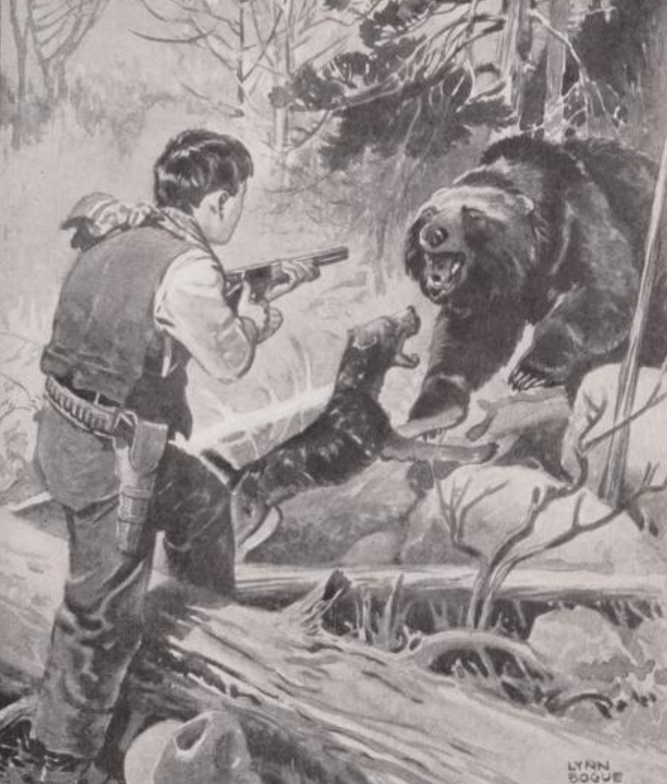
Al Kranbuhl
=======================================
Airedale performance breeder selection summary:
While I like a beautiful specimen and perfect example of a breed as much as anyone looks are last on my list when it comes to breeding for performance decisions, be they big, small, slick coat, long coat, hard coat, soft coat, heavy eared, if they are best performing "HUNTING DOGS" they are the ones that are bred and hopefully reproduced.
When it comes to a hunting dog as a breeding prospect I will assume nothing. They will have to show me! I have seen far too many dogs with supposedly can’t miss pedigrees that ended up being sorry. I will introduce them to targeted game and check for bred in instincts needed by a hunting dog and to see if there is enough potential to mess with. I look for a desire, drive and ability to hunt, traits like a good nose, tracking, locating and treeing, grit, etc.
Evaluating pups for hunting is not a heck of a lot different that a little league coach looking over a bunch of 10 or 11 year old boys playing ball for the first time. If you know what to look for it’s easily seen. The talent will rise to the top with time and while all the kids will be able to throw, swing a bat and run it will soon be apparent who can throw, hit and run and stand out doing it really well.
I evaluate pups much the same, I will take them afield at ten to twelve weeks old and set them up to show me what they were born with. First of all stay away from bottled scents, there is a big difference in the scent of an animal's natural scent and some piss in a bottle. I always use real animals to test dogs, either fresh intact dead, or live in roll cages. I will lay simple short scent trails, put out live animals, put them up in trees to check for natural treeing traits. I will walk the pups through these setups without doing or showing them a thing myself. I am looking at how they react naturally. After doing these types of drills for many years and watching hundreds of young dogs, I know what kind of reactions I am looking for.
Like the young ball players, there will be those that will just stand out and you know with the right kind of experience and work they will progress and be good ones. By the same token the cold hard facts are there will be some that all the coaching and training in the world is not going to help a whole lot.
For the young dogs that get over the hump in my first assessment go around I will then take them in the woods and field on wild game and alternately hunt them hard with a broke dog half the time and alone by themselves the rest of the time. I let them have a chance to show what they are made of. You then can pretty easily separate the pretenders who want to be and think they are a hunting dog from those that ARE hunting dogs and prove it doing good work on a consistent basis by putting game in the bag. The ones that show they can get it done, are the ones that get bred. Nothing revolutionary here, old school stuff that I learned through experience and from picking the brains of old timers that produced winners. The key is sticking with it.
Disqualifying qualities and traits that will eliminate an Airedale in my kennel.
1. Overly aggressive toward other dogs and wanting to fight all the time.
2. Overly aggressive and ill toward people, any tendency to bite a person for no reason.
3. Scatter-brained, mentally retarded, can’t sit still for a minute, too hard-wired. (like humans there is a wide range of intelligence and mental stability in dogs.)
4. Shy, skittish, cower at loud noises, afraid of their own shadow, tail down all the time.
I like to see what other hunters think and what their opinions are in such matters so for kicks I once went to several hunting dogs sites from Terriers and Hounds to Bird Dogs and put up polls asking those hunters what they considered the one worst fault a hunting dog could have. I tallied all the the responses I got and this is what played out.
1. 1973 listed Dog on Dog aggressiveness as the worst,
2. 1528 listed shyness/timidness,
3. 688 listed poor nose/inability-lack of interest to track targeted game well enough,
4. All other assorted combined responses 598.

Thursday, March 16, 2017
The Brown Bear Of Bellote
A condensed short story from Frank C Hibbon's Book "Hunting American Bears
Rod Vance, Cass Goodner and I had been hunting bears the past two days. We had ridden hard the past two days, it is true the country behind the San Ysidro was rough in the extreme. The cliffs and canyons of that part of the mountains dissected and crisscrossed by fault lines that produced a disordered maze of ledges and protruding rocks. Douglas fir and pine protruded from the rough rocks along with pinyon and juniper.
Into the rugged breaks and canyons of the San Ysidro the bear came in usually in the fall by the dozens. Of course it often seemed to us that these hardy animals by nature sought the roughest and rockiest terrain they could find. Cass had said on more than one occasion "it all looks level to a bear. On the lower reaches of Semilla Canyon this red rock gorge has some percolating water coming to the surface. Around these spots flourished groves of oak trees with graceful hanging clusters of delicious acorns. Long ago the Spanish rode their horses beneath these same oak trees and called the spot the Bellote or place of acorns.
The bears of Jemez country well knew of the Bellotte and it's acorns and this is the stuff black bears used to lay on the winter fat when the time of hibernation was close at hand. On former occasions the bellote groves had been a sure place to circle for a bear track. We had ridden perhaps a half mile and entered the first of the oak trees. With a sudden flapping of wings a hundred band tailed pigeons swept out of the trees, they had been gorging themselves on the acorns.
The three of us had grown silent after a half an hour riding, I swung low again to scrape my sombrero and shoulders beneath a low hanging limb weighted by last winter's snow, someone behind me said good god it's the dogs. I suddenly became aware that our hounds had gone crazy. Every dog we had was barking at the top of their lungs. It seemed like the pack was baying us which was preposterous for a well trained pack of hounds such as these. Even our horses were ill at ease in this strange melee.
All of a sudden as they had begun the dogs were still. Every single hound stood near the head of my horse with ears elevated to the alert and nose pointing into the wind.The we heard it too, it was a crash in the oaks off to one side of the trail, the swish of a heavy body off young trees. The dogs all looked toward the sound and broke out anew, they were off like Beagles with a rabbit in sight. We knew it was no rabbit that made those crashing sounds.
We spurred our mounts and hacked through the oaks in a reckless gallop and crashed on following the noise and confusion ahead. The dogs were growling and baying and some of their voices sounded muffled as though they barked with their mouths full of meat. My horse saw it first, as we cleared the last oaks this docile animal shied skittishly and I was thrown and dropped to the very edge of the wash. My mouth and hands full of gravel as I got up to look for my horse. Instead all I saw was the head and forequarters of a gigantic bear My horse with my rifle in the saddle boot had galloped off down the wash.
At first all I could see was the bear's head and neck since his lower portions were obscured by the advancing and retreating hounds in front of him. Then all at once the beleaguered animal rose on his hind legs to fight off the dogs from that height. I was on my knees trying to remove my chaps and stared into the open mouthed towering bear beyond, it was a giant bear.
Standing spraddle legged on his hind legs the furious animal plied his paws from both sides. The curved claws stuck out beyond his toes and looked as long as tines on a pitchfork. Time and time again the bear fell forward as some dog came close trying to gather an audacious hound between those frightful jaws. The light footed hounds would bounce warily out of his reach, he ground his teeth together and saliva flew in bloody strings from his mouth as he slung his head side to side to meet any onslaught.
Cass was yelling over the turmoil "save the dogs" although I could not see how at the moment what we could do about it. Rod Vance came in from the side with his rifle in hand. I saw him raise the weapon once then lower it reluctantly as the dogs surged about their antagonist in a melee of moving tails and teeth. The bear in the middle of that hound pack suddenly bellowed like a bull and charged the dogs and ourselves as well. It was plain to see the bear was far to heavy to climb a tree even if there was a sizable one at hand. So ponderous was this huge animal that he could not even run for it to find refuge in the cliffs and ledges so close to us. None of us could keep our eyes from the flashing teeth and swinging claws, it was a battle to the death that we were witnessing and the only question was how many deaths there would be.
Cass was screaming above the turmoil "quick shoot close in" To add emphasis he grabbed Vance's arm and jerked him toward the bear. Then I saw it! It was Poncho the Airedale, This remarkable dog was supposed to be a house pet but he had been on so many hunts with Cass that he undoubtedly considered himself to be the mainstay of the bear pack. Pancho was a peculiar duality he could be as gentle as a newborn kitten or a raging demon of flashing white teeth and hideous growls. It was Poncho with his Airedale temper that precipitated the end. The Airedale somehow worked his way behind the bear and in one sudden leap jumped clear onto the bear's back and seized the animal by the side of his face. In the swirl and surge of the fighting Pancho was an added lump of furiously clawing fur and feet on the very top of the bear's head. The astounded bear ducked as though a bee had stung him unexpectedly in an unprotected place. He raised both paws to his face and brushed furiously at the dog on his head. it would have been funny had we not known that Pancho's death was only inches away.
For a second the audacious dog clung to one bear ear chewing that unprotected organ unmercifully and clawing the bear's face. Then one huge paw swung from behind. The hooked claws in unison caught behind Pancho's shoulders and swept him forward as inevitably as doom itself. For an awful second the bear held the Airedale between his paws like a squirrel about to crack a nut, then the huge head bent forward and those frightful jaws opened like the white rimmed mouth of hell. There was a sickening crunching of fiber and flesh and Pancho dropped limply and fell at the bear's feet.
At the same instant a deafening blast of noise blotted out all other sounds. Rod Vance was among the dogs with a smoking rifle in his hand. Quickly he levered another shell and fired point blank into the bear's neck. A streak of fur flew out behind as the bullet carried through. The bear looked up surprised at this interruption. His little bear eyes seemed to focus for the first time at the forms of men. The eyes seemed suddenly darker as e stood there with his paws hanging useless in mid air. They then misted over like a hazy cloud drifting before the sun. The great body stood a moment more among the dogs reluctant to give way. Then without a soundthe huge animal slumped forward and sagged into a heap of formless fur on the ground.
Everyone seemed stunned by the abruptness of the end. Only Cass leaped forward to seize one of the gigantic paws and roll the carcass away from the Airedale. Pancho lay as lifeless as the bear and we carried him gently out and laid him on the oak leaves. Cass put his hand behind the foreleg of this fearless Airedale and we held our breath. Cass nodded slowly, Pancho's heart was still beating. In a few moments the jaws of the Airedale trembled a little and his red tongue out over his bruised lips. his eyes flickered open and he seemed to recognize friends, he licked our hands as we held him.
Today Pancho has a patch of light colored skin on the side of his head where the teeth of the big bear had torn the flesh away from his skull. This Airedale is one of those few pioneer spirits to be scalped and yet live to tell about it.
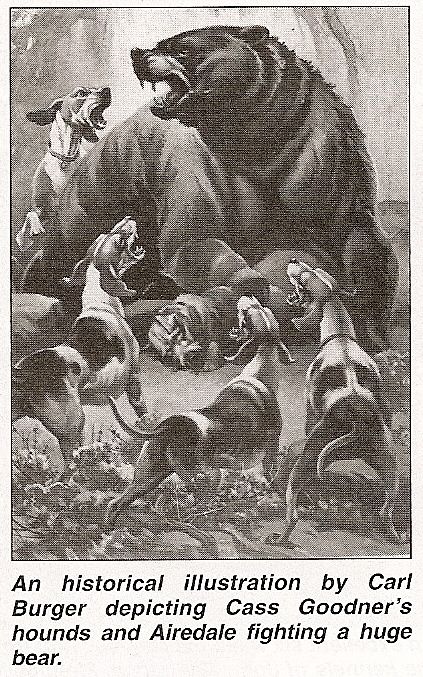
Rod Vance, Cass Goodner and I had been hunting bears the past two days. We had ridden hard the past two days, it is true the country behind the San Ysidro was rough in the extreme. The cliffs and canyons of that part of the mountains dissected and crisscrossed by fault lines that produced a disordered maze of ledges and protruding rocks. Douglas fir and pine protruded from the rough rocks along with pinyon and juniper.
Into the rugged breaks and canyons of the San Ysidro the bear came in usually in the fall by the dozens. Of course it often seemed to us that these hardy animals by nature sought the roughest and rockiest terrain they could find. Cass had said on more than one occasion "it all looks level to a bear. On the lower reaches of Semilla Canyon this red rock gorge has some percolating water coming to the surface. Around these spots flourished groves of oak trees with graceful hanging clusters of delicious acorns. Long ago the Spanish rode their horses beneath these same oak trees and called the spot the Bellote or place of acorns.
The bears of Jemez country well knew of the Bellotte and it's acorns and this is the stuff black bears used to lay on the winter fat when the time of hibernation was close at hand. On former occasions the bellote groves had been a sure place to circle for a bear track. We had ridden perhaps a half mile and entered the first of the oak trees. With a sudden flapping of wings a hundred band tailed pigeons swept out of the trees, they had been gorging themselves on the acorns.
The three of us had grown silent after a half an hour riding, I swung low again to scrape my sombrero and shoulders beneath a low hanging limb weighted by last winter's snow, someone behind me said good god it's the dogs. I suddenly became aware that our hounds had gone crazy. Every dog we had was barking at the top of their lungs. It seemed like the pack was baying us which was preposterous for a well trained pack of hounds such as these. Even our horses were ill at ease in this strange melee.
All of a sudden as they had begun the dogs were still. Every single hound stood near the head of my horse with ears elevated to the alert and nose pointing into the wind.The we heard it too, it was a crash in the oaks off to one side of the trail, the swish of a heavy body off young trees. The dogs all looked toward the sound and broke out anew, they were off like Beagles with a rabbit in sight. We knew it was no rabbit that made those crashing sounds.
We spurred our mounts and hacked through the oaks in a reckless gallop and crashed on following the noise and confusion ahead. The dogs were growling and baying and some of their voices sounded muffled as though they barked with their mouths full of meat. My horse saw it first, as we cleared the last oaks this docile animal shied skittishly and I was thrown and dropped to the very edge of the wash. My mouth and hands full of gravel as I got up to look for my horse. Instead all I saw was the head and forequarters of a gigantic bear My horse with my rifle in the saddle boot had galloped off down the wash.
At first all I could see was the bear's head and neck since his lower portions were obscured by the advancing and retreating hounds in front of him. Then all at once the beleaguered animal rose on his hind legs to fight off the dogs from that height. I was on my knees trying to remove my chaps and stared into the open mouthed towering bear beyond, it was a giant bear.
Standing spraddle legged on his hind legs the furious animal plied his paws from both sides. The curved claws stuck out beyond his toes and looked as long as tines on a pitchfork. Time and time again the bear fell forward as some dog came close trying to gather an audacious hound between those frightful jaws. The light footed hounds would bounce warily out of his reach, he ground his teeth together and saliva flew in bloody strings from his mouth as he slung his head side to side to meet any onslaught.
Cass was yelling over the turmoil "save the dogs" although I could not see how at the moment what we could do about it. Rod Vance came in from the side with his rifle in hand. I saw him raise the weapon once then lower it reluctantly as the dogs surged about their antagonist in a melee of moving tails and teeth. The bear in the middle of that hound pack suddenly bellowed like a bull and charged the dogs and ourselves as well. It was plain to see the bear was far to heavy to climb a tree even if there was a sizable one at hand. So ponderous was this huge animal that he could not even run for it to find refuge in the cliffs and ledges so close to us. None of us could keep our eyes from the flashing teeth and swinging claws, it was a battle to the death that we were witnessing and the only question was how many deaths there would be.
Cass was screaming above the turmoil "quick shoot close in" To add emphasis he grabbed Vance's arm and jerked him toward the bear. Then I saw it! It was Poncho the Airedale, This remarkable dog was supposed to be a house pet but he had been on so many hunts with Cass that he undoubtedly considered himself to be the mainstay of the bear pack. Pancho was a peculiar duality he could be as gentle as a newborn kitten or a raging demon of flashing white teeth and hideous growls. It was Poncho with his Airedale temper that precipitated the end. The Airedale somehow worked his way behind the bear and in one sudden leap jumped clear onto the bear's back and seized the animal by the side of his face. In the swirl and surge of the fighting Pancho was an added lump of furiously clawing fur and feet on the very top of the bear's head. The astounded bear ducked as though a bee had stung him unexpectedly in an unprotected place. He raised both paws to his face and brushed furiously at the dog on his head. it would have been funny had we not known that Pancho's death was only inches away.
For a second the audacious dog clung to one bear ear chewing that unprotected organ unmercifully and clawing the bear's face. Then one huge paw swung from behind. The hooked claws in unison caught behind Pancho's shoulders and swept him forward as inevitably as doom itself. For an awful second the bear held the Airedale between his paws like a squirrel about to crack a nut, then the huge head bent forward and those frightful jaws opened like the white rimmed mouth of hell. There was a sickening crunching of fiber and flesh and Pancho dropped limply and fell at the bear's feet.
At the same instant a deafening blast of noise blotted out all other sounds. Rod Vance was among the dogs with a smoking rifle in his hand. Quickly he levered another shell and fired point blank into the bear's neck. A streak of fur flew out behind as the bullet carried through. The bear looked up surprised at this interruption. His little bear eyes seemed to focus for the first time at the forms of men. The eyes seemed suddenly darker as e stood there with his paws hanging useless in mid air. They then misted over like a hazy cloud drifting before the sun. The great body stood a moment more among the dogs reluctant to give way. Then without a soundthe huge animal slumped forward and sagged into a heap of formless fur on the ground.
Everyone seemed stunned by the abruptness of the end. Only Cass leaped forward to seize one of the gigantic paws and roll the carcass away from the Airedale. Pancho lay as lifeless as the bear and we carried him gently out and laid him on the oak leaves. Cass put his hand behind the foreleg of this fearless Airedale and we held our breath. Cass nodded slowly, Pancho's heart was still beating. In a few moments the jaws of the Airedale trembled a little and his red tongue out over his bruised lips. his eyes flickered open and he seemed to recognize friends, he licked our hands as we held him.
Today Pancho has a patch of light colored skin on the side of his head where the teeth of the big bear had torn the flesh away from his skull. This Airedale is one of those few pioneer spirits to be scalped and yet live to tell about it.

Tuesday, February 28, 2017
Breeding! Choosing Your Experts!
As one becomes seriously involved in hunting dogs it does not take long before the subject of breeding comes up. Breeding is one of those deep subjects with enough information and opinions to fill volumes and even libraries. One thing is for sure nobody has the market cornered on how to breed, there are many views and methods and many have their merits but some I think are just plain hogwash.
Whatever the methods that are used there is absolutely no doubt in my mind that no matter what the hunting dog breed one is involved with, breeding correctly is the key to successful performing hunting dogs in the field, the big question is finding and using the right key.
Big Game Pack On Bear
![[image] [image]](https://blogger.googleusercontent.com/img/proxy/AVvXsEg7XgyxG9WW4EAUr6IgSOI3v5L9YKlTxmnhwPEruzaiFJDpJk-wOB8Fi5la_LqrbPxZKJ_G5qTMXn5rZAmEiglqn5Xf3Fj6HNm1R9R0o3R5-KJ_ejuYnj8a8FJyO03MLkMFSYg_W7zglV0vJEp7CasvsVWvwsqWLGWVicp0ThZ-Bz1oo1uQUwJpKrUCcwQSwBptP8qS480M_czz3LeeqQ=) | ||
I am constantly asked to give advice about breeding and how I go about the breeding of my own hunting dogs and advice on how to go about obtaining a good prospect. As mentioned above I have come to believe that there is no one single method to success. When I first got involved in breeding my own dogs I read everything about genetics that I could get my hands on. I quickly found out that the volume of information about genetics is huge and for me to be perfectly honest, "overwhelming". In my early days of breeding dogs I tried to apply all of this new found genetic knowledge but had so so success producing dogs that were below average to average performers.
Lucky for me I grew up in a hunting dog culture of mostly houndsmen that hunted Rabbits and Hare, along with Coon and Fox. My Dad, many of my uncles along with their cronies were all hunting dog men and when they got together the talk was about dogs and invariably about breeding.
I learned a long time ago to take advantage of the knowledge "experienced successful" breeders have and would try and glean anything I could from them. As one old timer said, "don't take advice from want to be breeders who have been pretty much unsuccessful breeders themselves. If their methods were worth using they would have been proven by their successes.
Most if not all of the old time successful did not learn a whole lot about breeding from books, everything they learned was trial and error and time proven breeding methods that have been passed around and down by dog breeders for centuries. These methods for the most part are just some one line sayings but powerful in their content and when used in conjunction with each other have proven themselves time and time again by producing great lines of hunting dogs in all breeds. Seemingly little details are vital and as they add up they can make big things happen.
So below are all the little bits of information I saved and stored away from "successful breeders" and a few that I came up with myself that I believe will help anyone who is serious about breeding for performance and in this case performance as a "hunting dog." I try to heap as many of these thoughts into any mating I make and for the most part my hunting dogs turn out to be pretty decent and suit me and most other hunters that have used them. They are in no particular order.
1. Know your breeding goal and recognize what you are seeing, save to the hard drive (your Brain). When breeding for the hunt that is what must come before all else. When one has the right kind of hunt entrenched in their line they then have a much better situation in dealing with stuff in the looks department, coat, size and conformation. When getting started with breeding stock do your homework and start with the very best known examples of your chosen breed that you can obtain because the best breeder in the world can not make a silk purse out of a sow's ear!
2. Keen observation, all the great hunting dogs I have had the pleasure of watching in the field share common denominators.
Essential traits. temperament, healthy constitution and body that can hold up to the rigors for stamina, drive, gaminess, nose, toughness-grit, ability and brains to use it all. Fish Creek & Branko bred Beagles, Hardtime, Junior, Boyd's Little Joe bred English Coon Hounds and Grouse Ridge English Setters are lines I have had the pleasure of owning and hunting and have nothing but the greatest respect for the breeders that produced them. A hunting dog obtained from these lines is going to have a very high rate of success of turning out to be a good hunting dog.
3. An animal's genetic makeup will determine it's hunting potential. How much of that potential good or bad that is actually achieved depends on the environment to which the dog is exposed. The definition of environment pertaining to this subject is how the dog is taken care of and fed, it's training and handling, and exposure to the game that is to be hunted.
4. Do not let what you have no control over interfere with what you can do.
5. The most important equation when breeding dogs for hunting is producing dogs that actually put game in the bag consistently.
6. Selection of your breeding stock is an art that will come as experience is gained, you will find the good ones all possess common traits and with that experience you will know it when you see it.
7. Success is many times better when if possible breeding to the stud that produced the champ than breeding to the champ himself.
8. Do not mate together non complementary types, the ability to recognize type at a glance is a breeder's greatest gift. The definition of non complementary types as ones that have the same faults and lack the same virtues. Do not mate together two dogs with the same bad fault, you are asking for trouble if you do.
9. Do not forget it is the whole dog that counts, if you forget one virtue while searching for another you will pay for it. But remember no hunting dog is absolutely perfect so do not be afraid of breeding to a dog with obvious faults as long as they are not too bad and has compensating virtues. A lack of virtues is the greatest fault of all.
10. Over the long term I think of myself as a strong pedigree builder, I see a pedigree as a multi stranded steel cable. Each dog in a pedigree represents a strand and I want each strand to be strong. I try my best to make sure every dog in my pedigrees is a good one. The more good strong strands added to the cable the better your line will be with consistent percentage of good performers. Keep adding those good strands.
11. "Breed workers to Workers", this old time saying goes hand and hand with what is written above along with this one, "you will reap what you sow". Breeding to an unproven weak dog will just bring your line down.
12. Breed for balance, too much of any one good trait many times tends to upset the applecart.
13. Don't make indiscriminate outcrosses, a "judicious outcross" can be of great of great value and improve your line, an injudicious outcross can produce an aggregation of any imaginable fault in the breed!
14. Do not allow personal feeling influence your choice of a stud dog, The right dog for your bitch is the right dog whoever owns it.
15. Evaluate your dogs honestly, do not credit your own dogs with virtues that they do not possess, self deceit is a sure stepping stone to failure.
16. I have over the years become a believer in the so called line breeding method when it comes to performance. But! you do not line breed just for the sake of line breeding. Line breeding to complementary dogs can and do bring great rewards, breeding to unsuitable types will lead to immediate disaster.
17. Even when you think everything possible has been done to produce that litter of perfect pups as famed hound breeder John Wick puts it, "Every pup is like a lottery ticket, except that you have to feed it for a year before you can scratch it to see what you got. Sometimes the mating pays and sometimes it does not."
18. I once heard that it is what you learn when after thinking you know it all that counts, knowledge about breeding is never ending so do not get too full of yourself and keep your ears open.
So in the end it will be your dogs doing the talking as to what kind of performance breeder you are. As the old coon hunter's saying goes "When the tailgate drops the bullshit stops" Performance in the field will be the ultimate judge of a breeder, the word gets out about the good lines that produce game consistently and the same goes for those whom are producing sorry ones that do not.
Al Kranbuhl
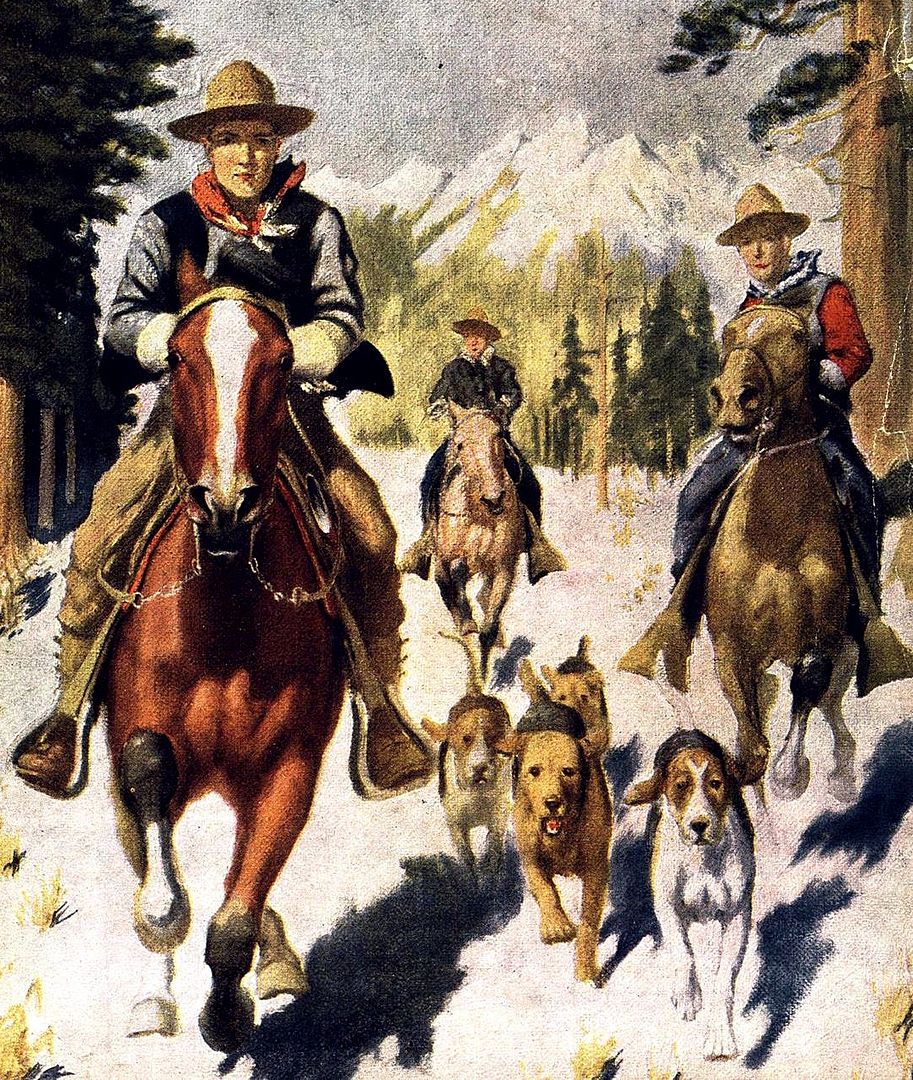

Tuesday, March 18, 2014
Hunting Airedales In Action 2
A few more additional photos of "VERSATILE" hunting Airedales from the Traditional Working Airedale message board. Being successfully used for hunting pretty much all of North American game.
http://traditionalairedale.proboards.com/
Bobby Harper's Hog hunting pack W/young Airedale "Donnie" with a boar in a water hole.
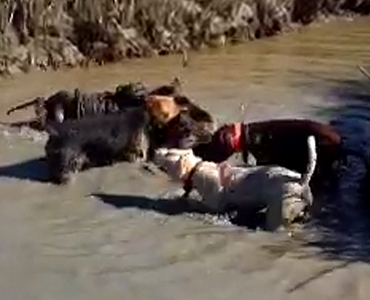
Tigger retrieving a Pheasant

Audwin MagGee's Scout Hogging
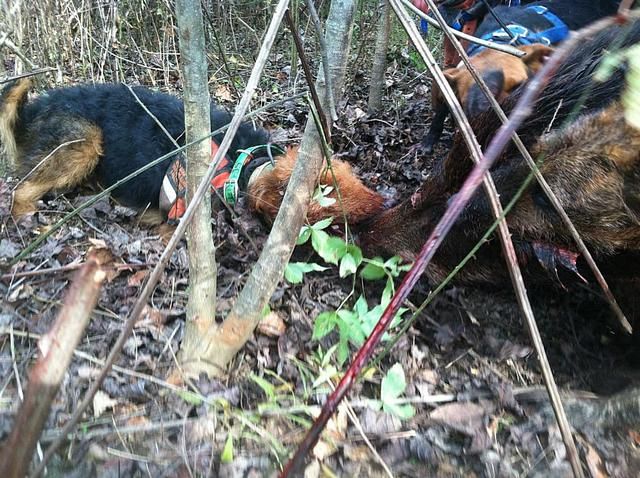
Ruby recovers a nice Buck
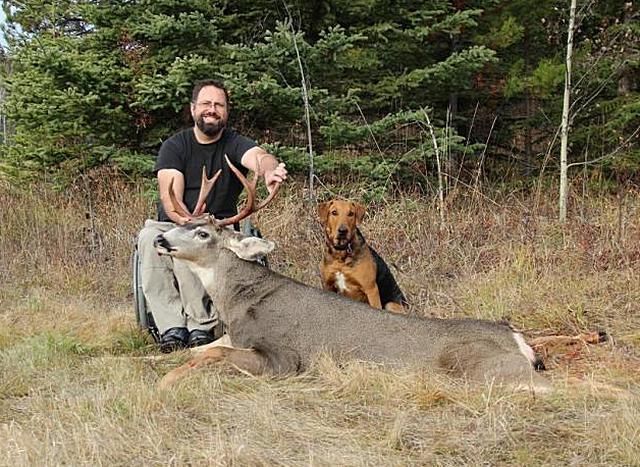
Rock Creek Pack with Hog
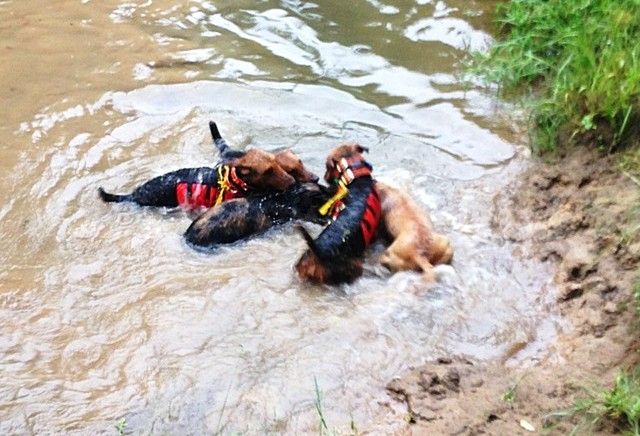
Scott Cain & Airedale = Successful Hog Hunt
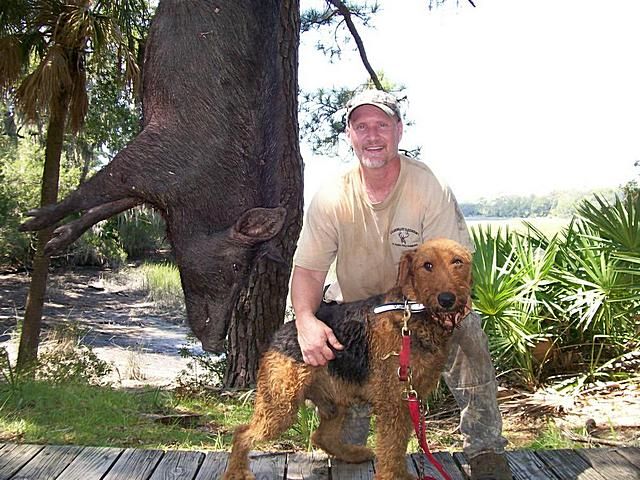
Wayne Hill's Katie with treed Bear

Richard McCorkle & Grizz with nice Hog
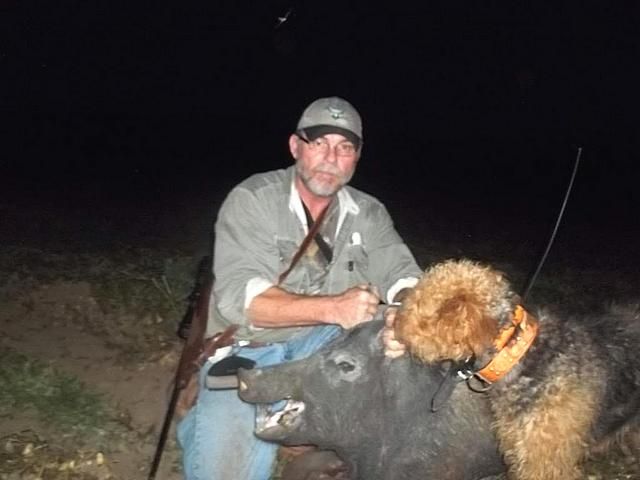
Rick Underwood's Max with a nice water retrieve
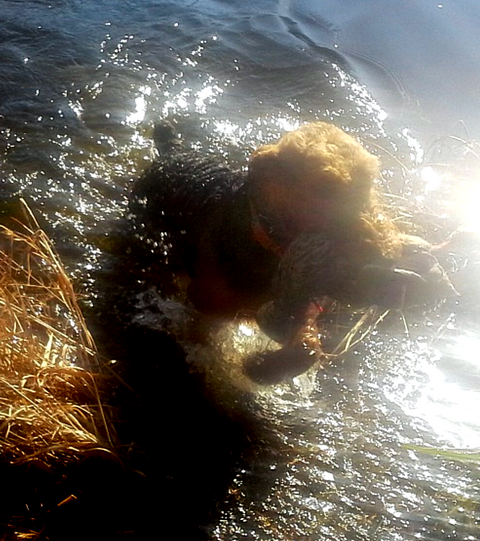
Rock Creek Airedales with nice Hog
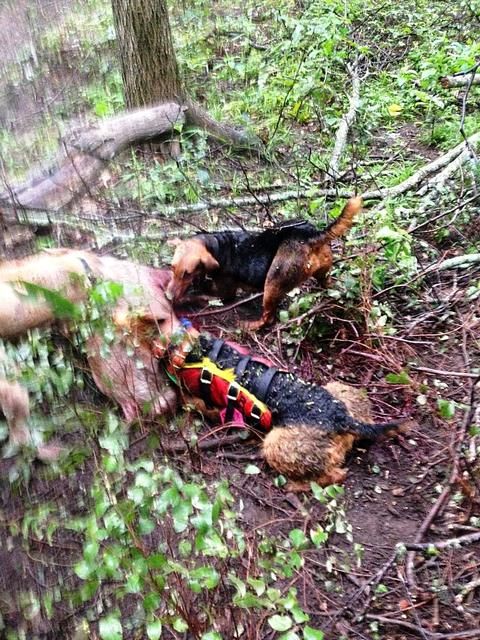
Todd Kennedy's Cur & Airedale "Scout"

Kent Cowell's lion pack With Airedale "Hammer"
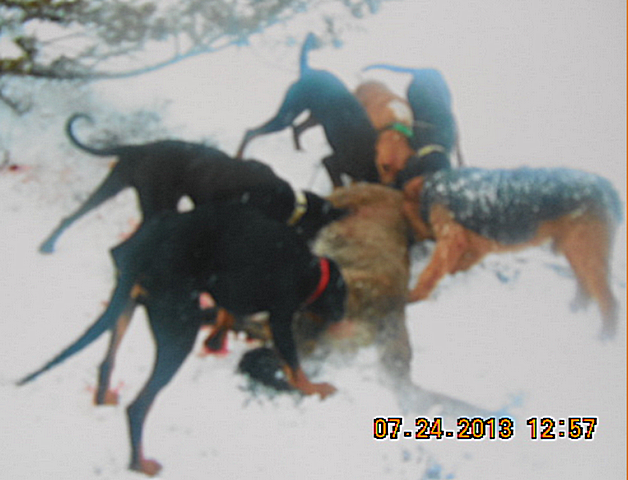
Another Deer recovery by Richard McCorkle's "Grizz"

Jack Harris's MaGee & Pearl
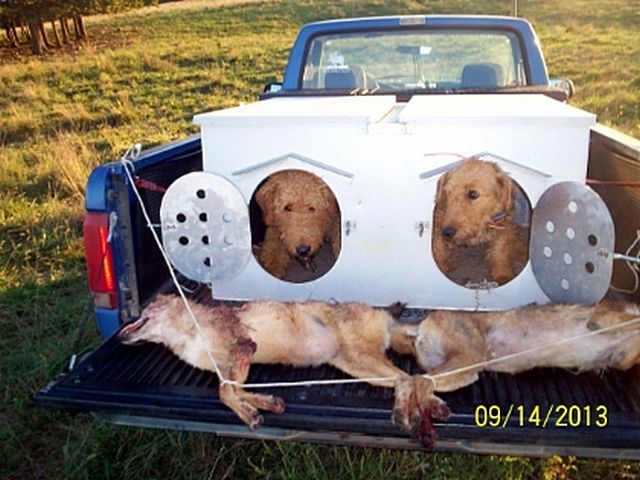
Rick Underwood's "Max" W/Coon he tracked and Treed on his own.
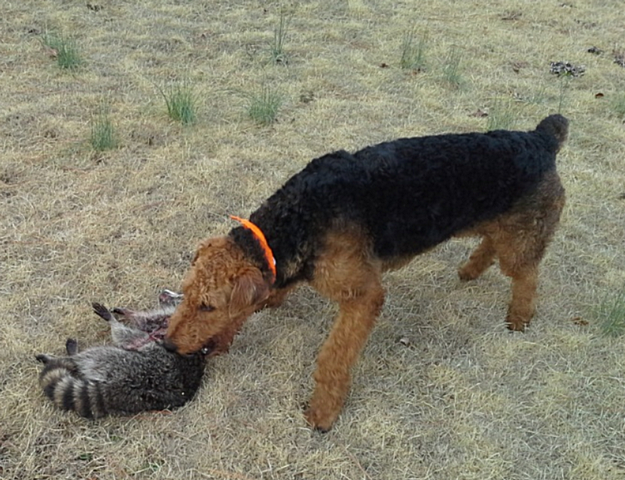
A Nice Mixed Bag
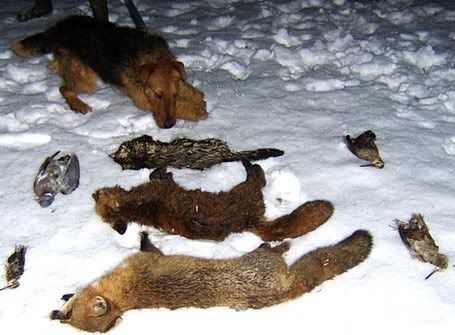
Bobby Harper and his Airedale "Donnie" High On The Hogs
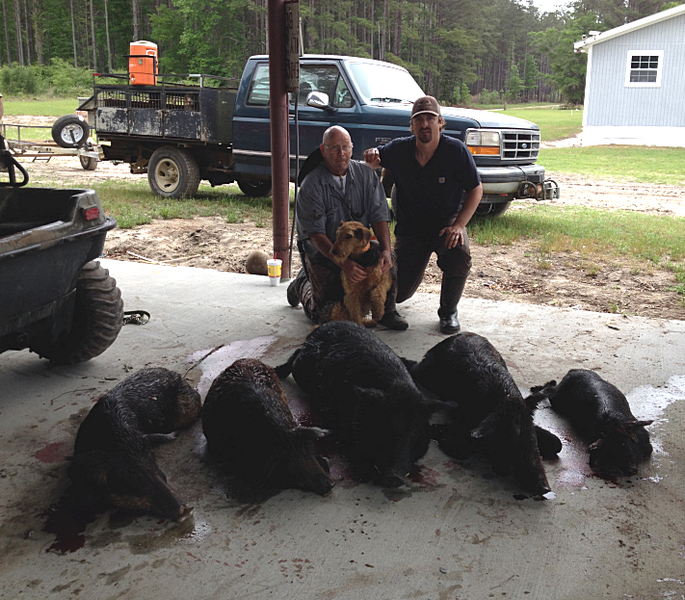
Lion Hunt Short Video Clip, click on box below, the video is still there.
Sports Afield
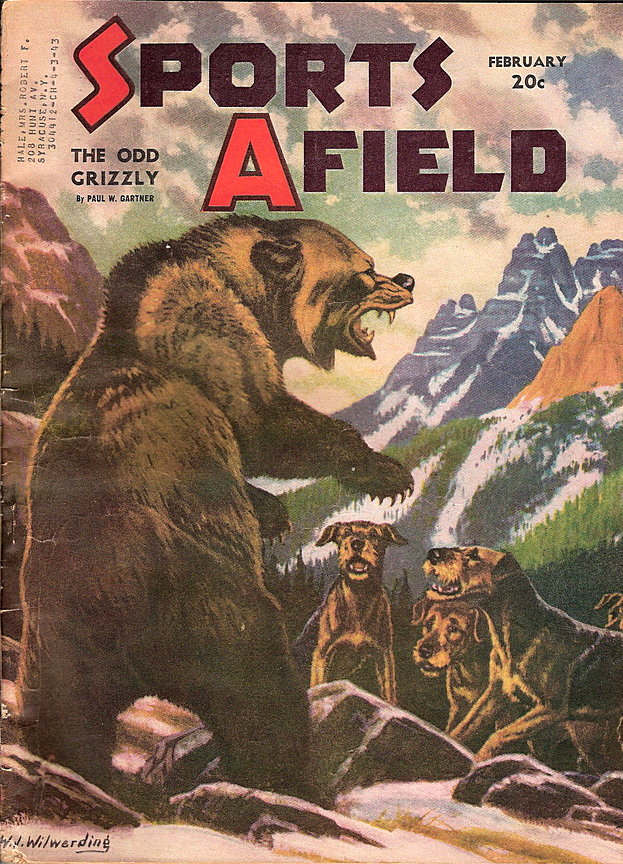
Al Kranbuhl's young female Harleigh
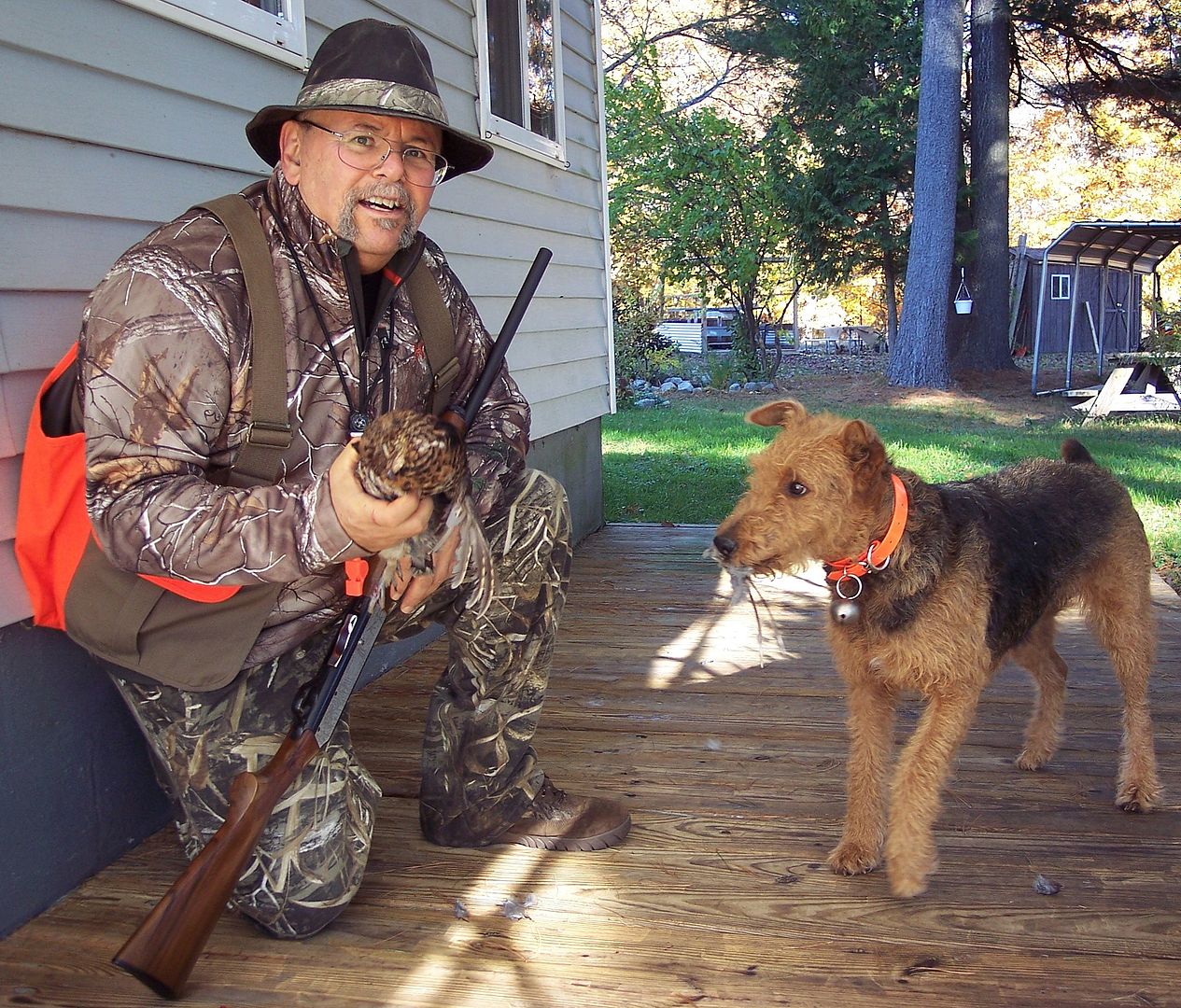
http://traditionalairedale.proboards.com/
Bobby Harper's Hog hunting pack W/young Airedale "Donnie" with a boar in a water hole.

Tigger retrieving a Pheasant

Audwin MagGee's Scout Hogging

Ruby recovers a nice Buck

Rock Creek Pack with Hog

Scott Cain & Airedale = Successful Hog Hunt

Wayne Hill's Katie with treed Bear

Richard McCorkle & Grizz with nice Hog

Rick Underwood's Max with a nice water retrieve

Rock Creek Airedales with nice Hog

Todd Kennedy's Cur & Airedale "Scout"

Kent Cowell's lion pack With Airedale "Hammer"

Another Deer recovery by Richard McCorkle's "Grizz"

Jack Harris's MaGee & Pearl

Rick Underwood's "Max" W/Coon he tracked and Treed on his own.

A Nice Mixed Bag

Bobby Harper and his Airedale "Donnie" High On The Hogs

Lion Hunt Short Video Clip, click on box below, the video is still there.
Post by Airedale From NY on 23 hours ago
Post by Airedale From NY on 9 hours ago
Post by Airedale From NY on 6 minutes ago

Al Kranbuhl's young female Harleigh

Subscribe to:
Posts (Atom)
